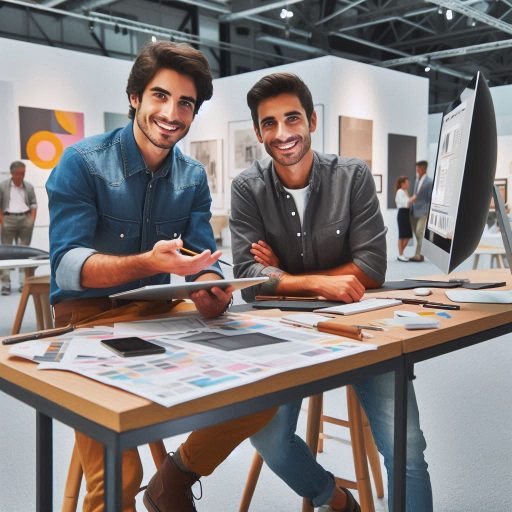Introduction
Overview of Exhibition Design
Exhibition design focuses on creating spaces that display information and artifacts effectively.
It combines art, architecture, and storytelling to enhance visitor experiences.
Designers work to make complex subjects accessible and engaging for diverse audiences.
Importance of Exhibition Design
Exhibition design plays a crucial role in showcasing information.
Well-designed exhibits attract attention and encourage exploration.
Engaging visitors through interactive elements fosters a deeper understanding of the content.
Effective design can influence visitor emotions and reactions, making the experience memorable.
Additionally, thoughtful layouts guide movement and interaction, enhancing overall visitor satisfaction.
A well-executed exhibition can communicate themes and messages clearly, allowing audiences to connect with the subject matter.
Evolution of Exhibition Design
The evolution of exhibition design has transformed how we experience information.
Early exhibits focused primarily on display and organization.
Over the years, designers began incorporating technology, multimedia, and interactivity into their projects.
This shift enhanced visitor engagement and understanding.
In recent years, sustainable design practices have emerged, prioritizing eco-friendly materials and processes.
Additionally, immersive experiences that blend physical and digital elements are gaining popularity.
Today‘s exhibitions increasingly reflect societal trends and technological advancements, creating dynamic environments that resonate with audiences.
Early History of Exhibition Design
Exploring the Origins of Exhibition Organization
Exhibitions have evolved significantly since their inception.
The earliest exhibitions emerged in ancient civilizations, showcasing art and culture.
These gatherings often celebrated achievements, festivals, or trade.
Ancient Greeks organized exhibitions during their Panhellenic Games, featuring artistic and athletic displays.
Similarly, medieval fairs highlighted local crafts and products, attracting traders and visitors.
As societies advanced, so did the organization of exhibitions.
The Industrial Revolution spurred the growth of world’s fairs, showcasing technological advancements.
These large-scale events attracted international attention and fostered cultural exchange.
Early exhibitions aimed to educate the public about innovations and ideas.
They laid the groundwork for modern exhibition practices.
Basic Design Elements in Early Exhibitions
Early exhibitions employed basic design elements to convey messages effectively.
Simplicity defined their layouts, often featuring open spaces for easy navigation.
Organizers arranged exhibits linearly, allowing visitors to progress from one display to another.
This straightforward approach facilitated comprehension and engagement.
The use of signage was crucial in early exhibitions.
Clear labels identified exhibits, providing essential information to visitors.
Organizers utilized banners and posters to highlight key attractions.
These basic design elements ensured that attendees understood the purpose of each exhibit.
Exhibition spaces often featured a mix of natural and artificial lighting.
Early organizers capitalized on daylight to enhance visibility.
They strategically placed exhibits near windows to create inviting environments.
As technology advanced, artificial lighting began to play a more prominent role.
Exhibitors experimented with lighting to emphasize specific artworks or artifacts.
Objectives of Early Exhibitions
The primary objectives of early exhibitions revolved around education and awareness.
Organizers aimed to inform visitors about new ideas and innovations.
They presented art and culture in accessible formats, fostering public appreciation.
Early exhibitions served as platforms for dialogue among artists, scientists, and the public.
Design and layout played significant roles in achieving these objectives.
Organizers focused on creating engaging experiences for visitors.
They aimed to stimulate curiosity and provoke thought through thoughtfully arranged displays.
The linear layout facilitated a logical progression through the exhibition, enhancing understanding.
Furthermore, early exhibitions sought to establish cultural identity.
They showcased local crafts and traditions, reinforcing community pride.
By highlighting regional achievements, these exhibitions fostered a sense of belonging among attendees.
Exhibitions also aimed to promote commerce and industry.
Organizers showcased products to attract potential buyers and investors.
They created spaces that facilitated networking and business opportunities.
This focus on commerce influenced design decisions, prioritizing accessibility and visibility for exhibitors.
The evolution of exhibition design reveals a rich history of creativity and adaptation.
Early exhibitions showcased art and culture, focusing on education and community engagement.
Basic design elements, such as simple layouts and effective signage, were crucial for communication.
As exhibitions evolved, their objectives expanded to include commerce and cultural identity.
Today‘s exhibitions build on this foundation, incorporating advanced design techniques and technology to enhance visitor experiences.
Read: Ceramic Art: From Hobby to Professional Career
The Industrial Revolution and its impact on exhibition design
Analyzing How Technological Advancements Influenced Exhibition Design
Technological advancements have significantly influenced the evolution of exhibition design.
From the introduction of electricity to the rise of digital media, technology has transformed how exhibitions are presented.
Electric lighting, for example, allowed for more dynamic and varied displays.
Designers could highlight artwork and artifacts in innovative ways, enhancing visibility and atmosphere.
The advent of digital technology revolutionized exhibitions further.
Interactive screens and projection mapping engage visitors like never before.
These tools allow for immersive experiences that draw people into the narrative.
Digital storytelling can enhance understanding and emotional connection to the content.
Technology enables exhibitions to adapt quickly to audience feedback, creating a more responsive experience.
Moreover, virtual reality (VR) and augmented reality (AR) have created new dimensions in exhibition design.
These technologies transport visitors to different environments, providing unique perspectives on the subject matter.
By incorporating VR and AR, designers can offer experiences that are both educational and entertaining.
This trend marks a significant shift in how audiences interact with exhibitions.
Discussing the Shift Towards More Elaborate Displays and Interactive Elements
In recent years, exhibitions have shifted toward more elaborate displays and interactive elements.
This evolution reflects changing visitor expectations and engagement strategies.
Audiences today seek experiences that go beyond passive observation.
They desire active participation and emotional connections with the content.
Designers now create spaces that encourage exploration and interaction.
Hands-on exhibits, interactive installations, and immersive environments invite visitors to engage fully.
This shift enhances learning and retention, making the experience memorable.
Visitors are more likely to share their experiences with others, amplifying the exhibition’s reach.
Elaborate displays also allow for storytelling on a grand scale.
Designers can use various materials, lighting, and spatial arrangements to convey narratives.
This approach creates an emotional journey for visitors, guiding them through the exhibition’s themes.
The more immersive the experience, the deeper the connection visitors form with the content.
Exploring How the Industrial Revolution Changed Exhibition Design
The Industrial Revolution marked a turning point in exhibition design and presentation.
This era introduced new materials, manufacturing techniques, and transportation methods.
These advancements enabled the creation of larger and more elaborate exhibition spaces.
Museums and galleries began to adopt a more formalized approach to exhibition design.
Standardized practices emerged, allowing for consistent presentation methods.
This period saw the rise of the world‘s fairs, showcasing technological innovations and cultural achievements.
These grand exhibitions became platforms for national pride and international collaboration.
During this time, designers also began to consider the visitor experience more holistically.
They focused on how spaces could guide audience movement and engagement.
Layouts became more intentional, ensuring visitors could navigate and interact with exhibits smoothly.
This emphasis on flow and accessibility laid the groundwork for modern exhibition design principles.
Overall, the evolution of exhibition design reflects ongoing technological advancements and changing audience expectations.
From the Industrial Revolution to the present day, designers continually adapt to new trends and tools.
As a result, exhibitions today offer richer, more engaging experiences that captivate and educate audiences.
Understanding this evolution helps designers create meaningful connections between visitors and the content presented.
Read: How to Create Memorable Characters: Pro Tips
Modern era and the rise of experiential design
The Concept of Experiential Design in Exhibitions
Experiential design transforms traditional exhibition spaces into engaging environments.
This approach emphasizes interaction and participation from visitors.
Rather than merely observing, guests actively engage with the content.
Experiential design considers all senses, creating memorable experiences that resonate emotionally.
Designers focus on storytelling, guiding visitors through narratives that unfold in the space.
The layout, lighting, and sound all contribute to the overall atmosphere.
This cohesive design fosters connections between the audience and the exhibits.
Experiential design elevates exhibitions beyond static displays, making them dynamic and compelling.
The Importance of Creating Immersive Experiences
Creating immersive experiences is crucial for engaging today‘s audiences.
Visitors often seek more than visual stimulation; they crave deeper connections.
Immersive exhibits encourage exploration and foster curiosity.
When visitors feel part of the experience, their emotional investment increases.
Immersive experiences enhance learning and retention.
Guests are more likely to remember what they see and do.
This active participation leads to richer educational outcomes.
Additionally, immersive environments stimulate conversations among visitors, enhancing social interactions.
These connections contribute to a sense of community, making exhibitions memorable.
Designing immersive experiences requires thoughtful planning and creativity.
Every detail, from the arrangement of artifacts to the integration of multimedia, matters.
The goal is to create a seamless flow that captivates visitors‘ attention.
By prioritizing immersive design, exhibitions can leave lasting impressions.
How Technology Has Revolutionized Exhibition Design
Technology has revolutionized exhibition design in profound ways.
Digital tools enable designers to create interactive and engaging installations.
Virtual reality (VR) and augmented reality (AR) allow visitors to explore exhibits from new perspectives.
These technologies break down traditional barriers, making art and culture accessible to all.
Touchscreens and multimedia displays enhance visitor interaction.
Guests can explore content at their own pace, diving deeper into topics of interest.
This level of customization increases engagement and satisfaction.
Additionally, gamification elements can transform learning into fun experiences, appealing to diverse audiences.
Data analytics also plays a crucial role in modern exhibition design.
Designers can track visitor behavior and preferences, informing future projects.
Understanding audience dynamics allows for tailored experiences that resonate more effectively.
Furthermore, technology facilitates remote access to exhibitions.
Virtual tours enable people from around the world to engage with content.
This accessibility broadens the audience base, fostering a global appreciation for art and culture.
The evolution of exhibition design reflects changing audience expectations and technological advancements.
Experiential design focuses on creating immersive experiences that engage all senses.
By embracing technology, designers can transform traditional exhibitions into interactive environments.
As this evolution continues, exhibitions will become increasingly dynamic, ensuring that they captivate and inspire future generations.
Ultimately, the integration of experiential design and technology will shape the future of how we experience art and culture.
Read: Ceramic Art Exhibitions to Visit in 2024

Sustainability and Eco-friendly practices in Exhibition Design
The Growing Emphasis on Sustainability in Exhibition Design
Sustainability has become a crucial focus in exhibition design.
As environmental concerns rise, designers prioritize eco-friendly practices.
This shift reflects a broader cultural awareness about climate change and resource conservation.
Modern exhibitions aim to minimize their ecological footprint while engaging audiences.
Exhibitors now seek ways to align their projects with sustainable values.
Many organizations and institutions have adopted sustainability guidelines for their exhibitions.
These guidelines encourage the use of renewable resources and responsible sourcing.
Designers now consider the entire lifecycle of materials, from production to disposal.
This approach ensures that exhibitions remain environmentally friendly from start to finish.
Incorporating Eco-Friendly Materials and Practices
Designers increasingly incorporate eco-friendly materials in their projects.
Recycled materials reduce waste and lower environmental impact.
Bamboo, for example, is a popular choice due to its rapid growth and renewability.
Many designers use reclaimed wood and repurposed fabrics for displays, giving new life to discarded materials.
Additionally, designers explore innovative materials that minimize harm.
Biodegradable options, such as plant-based plastics, are gaining popularity.
These materials break down naturally, reducing landfill contributions.
Low-VOC (volatile organic compounds) paints and finishes also improve indoor air quality.
Sustainable practices extend beyond materials.
Designers now prioritize energy efficiency in lighting and climate control.
Using LED lighting significantly lowers energy consumption while enhancing visibility.
Designers also consider the exhibition‘s overall design to optimize natural light, reducing reliance on artificial sources.
The Importance of Creating Environmentally Conscious Exhibitions
Creating environmentally conscious exhibitions benefits both the planet and visitors.
Such exhibitions raise awareness about sustainability issues among attendees.
When visitors encounter eco-friendly designs, they become more informed about their own environmental impacts.
These exhibitions can inspire behavioral changes.
Attendees may adopt sustainable practices in their lives after experiencing eco-conscious designs.
By showcasing sustainable solutions, exhibitions can serve as powerful educational tools.
They highlight the importance of caring for our planet while enjoying art and culture.
Moreover, sustainable exhibitions attract a growing demographic of environmentally conscious visitors.
Many people prefer events that align with their values.
Exhibitions that prioritize sustainability can enhance a brand‘s reputation and foster loyalty.
As consumers become more eco-aware, they seek out experiences that reflect their beliefs.
Exhibitors can also benefit financially from sustainable practices.
Eco-friendly materials and energy-efficient designs may reduce long-term operational costs.
These savings can enhance profitability while supporting environmental goals.
The evolution of exhibition design emphasizes sustainability in meaningful ways.
Designers increasingly incorporate eco-friendly materials and practices to reduce environmental impacts.
Creating environmentally conscious exhibitions not only educates visitors but also fosters positive change.
By prioritizing sustainability, exhibition designers contribute to a healthier planet.
As this trend continues to grow, it will shape the future of exhibition design.
Embracing eco-friendly approaches ensures that exhibitions resonate with modern audiences while promoting a sustainable future.
Read: Character Design Trends: What‘s Hot in 2024?
Cultural influences on exhibition design
Analyzing How Different Cultures Influence Exhibition Design
Exhibition design reflects the rich tapestry of global cultures.
Each culture offers unique perspectives, aesthetics, and narratives.
Designers draw inspiration from various cultural backgrounds to create compelling experiences.
This influence shapes not only visual elements but also the overall visitor experience.
For instance, Japanese minimalism emphasizes simplicity and tranquility.
Designers incorporate these principles to create calming environments.
In contrast, African art often features vibrant colors and intricate patterns.
These elements bring energy and movement to exhibitions, engaging visitors on multiple levels.
Understanding cultural context is vital for successful exhibition design.
Designers must respect and accurately represent the cultures they showcase.
This sensitivity fosters authentic connections between the exhibition and its audience.
By analyzing different cultural influences, designers enhance the depth and meaning of their work.
Transform Your Career Today
Unlock a personalized career strategy that drives real results. Get tailored advice and a roadmap designed just for you.
Start NowThe Use of Cultural Elements in Shaping the Design of Exhibitions
Cultural elements play a significant role in shaping exhibition design.
These elements can include traditional art forms, materials, and architectural styles.
By integrating these aspects, designers create immersive environments that resonate with visitors.
For example, a Native American art exhibition might feature traditional weaving techniques and natural materials.
This approach honors the cultural heritage while educating visitors about its significance.
Similarly, incorporating local folklore or myths can enrich the narrative of an exhibition.
Multimedia installations can also highlight cultural elements.
Designers can use video, sound, and interactive displays to bring stories to life.
This engagement fosters a deeper understanding of the culture being represented.
Additionally, cultural elements can guide the spatial organization of an exhibition.
Designers may create zones that reflect specific cultural themes or practices.
This thoughtful layout encourages exploration and interaction while respecting cultural boundaries.
How Designers Are Incorporating Diversity and Inclusivity in Their Designs
Incorporating diversity and inclusivity is essential in contemporary exhibition design.
Designers strive to represent a wide range of voices and experiences.
This effort creates a more comprehensive understanding of different cultures.
One approach is to collaborate with community members and cultural experts.
By involving these voices in the design process, exhibitions become more authentic and meaningful.
This collaboration fosters a sense of ownership and connection among diverse communities.
Designers also focus on accessibility when creating exhibitions.
Ensuring that exhibits cater to various abilities and backgrounds is crucial.
This includes providing tactile elements, audio guides, and multilingual signage.
An inclusive approach enhances the overall visitor experience for everyone.
Moreover, exhibitions increasingly showcase underrepresented artists and stories.
Highlighting diverse perspectives enriches the narrative and engages a broader audience.
By featuring a variety of cultural expressions, designers celebrate the richness of human experience.
In a nutshell, the evolution of exhibition design is deeply influenced by cultural elements.
Analyzing how different cultures shape design practices enhances authenticity and visitor engagement.
Incorporating diverse and inclusive approaches fosters a sense of belonging for all visitors.
As designers continue to embrace cultural influences, they create more enriching experiences that resonate with audiences worldwide.
Challenges facing exhibition designers
Common Challenges Faced by Exhibition Designers
Exhibition designers encounter numerous challenges throughout their projects.
Understanding these challenges is crucial for successful execution.
One major hurdle is budget constraints, which impact design choices.
Limited funding can restrict material quality and exhibit scale.
Designers often find themselves making tough decisions under financial pressure.
Another challenge is limited space.
Many venues have strict dimensions that designers must navigate.
Working within these confines requires creative thinking and innovative solutions.
Designers must optimize the use of available space while maintaining an engaging experience for visitors.
This balancing act can be quite demanding.
Time constraints also pose significant challenges.
Designers often work under tight deadlines, which can lead to rushed decisions.
Quick turnarounds may compromise the quality of the final product.
Balancing speed with quality is essential for a successful exhibition.
Budget Constraints and Limited Space
Budget constraints significantly affect the exhibition design process.
Designers must prioritize elements that fit within the allocated budget.
This often means selecting cost-effective materials and solutions.
However, limited funding does not have to mean lower quality.
Innovative designers find ways to stretch their budgets creatively.
They might source materials locally or use reclaimed items.
Limited space further complicates the design process.
Designers must maximize every square foot to create impactful experiences.
They consider flow and visitor interaction while designing exhibits.
This requires strategic planning and thoughtful layout design.
Effective use of vertical space can create a sense of depth and engagement.
Overcoming Challenges in Exhibition Design
Successful exhibition designers employ various strategies to overcome challenges.
Collaboration is essential in addressing budget constraints.
Designers work closely with clients to identify priorities.
This collaborative approach helps align goals and expectations.
Open communication often leads to innovative solutions that respect financial limits.
Creative problem-solving is also key to overcoming space limitations.
Designers frequently use modular displays and adaptable structures.
These elements allow for flexible arrangements that fit any space.
They can also reconfigure exhibits for different venues or events.
Utilizing technology provides another avenue for overcoming challenges.
Virtual reality and augmented reality offer immersive experiences without requiring extensive physical space.
These technologies enhance engagement while minimizing spatial limitations.
Digital solutions also reduce costs associated with physical materials.
Regular feedback from stakeholders can refine the design process.
Engaging clients and venue managers ensures that all parties stay informed.
This collaborative spirit fosters a sense of ownership in the project.
Moreover, designers often draw inspiration from successful past exhibitions.
Analyzing what worked well and what didn‘t helps inform future designs.
Learning from previous experiences is invaluable for continuous improvement.
Exhibition design is a dynamic field filled with challenges.
Budget constraints, limited space, and time pressures can complicate the process.
However, designers overcome these hurdles through collaboration, creativity, and technology.
By employing innovative strategies, they create successful exhibitions that engage and inspire audiences.
Understanding these challenges helps designers adapt and thrive in this ever-evolving industry.
Discover More: Balancing Art and Commerce in Textile Design
Conclusion
The evolution of exhibition design has transformed significantly over the years.
In its early history, exhibitions primarily focused on displaying objects in static formats.
Designers relied on simple layouts and minimal interaction, prioritizing object visibility.
As time progressed, exhibition design began to incorporate storytelling elements.
Curators started using thematic arrangements to guide visitors through narratives.
This approach added depth and context to exhibits, enhancing visitor engagement.
The modern era introduced advanced technologies that revolutionized exhibition design.
Designers now utilize virtual reality (VR), augmented reality (AR), and interactive displays.
These innovations create immersive experiences that captivate audiences and invite participation.
Staying innovative and adaptable is crucial in this ever-evolving field.
Designers must embrace new technologies and trends to remain relevant.
By continuously seeking fresh ideas, they can enhance visitor experiences and ensure exhibitions resonate with diverse audiences.
Exhibition design plays a vital role in conveying information effectively.
Thoughtful layouts and engaging narratives help visitors understand complex topics.
Additionally, well-designed exhibitions create memorable experiences that leave lasting impressions.
As the field continues to evolve, designers must prioritize creativity and adaptability.
By embracing change, they can craft impactful exhibitions that engage, inform, and inspire visitors.
[E-Books for Sale]
The Big Book of 500 High-Paying Jobs in America: Unlock Your Earning Potential
$19.99 • 500 High-Paying Jobs • 330 pages
Explore 500 high-paying jobs in America and learn how to boost your career, earn more, and achieve success!
See All 500 High-Paying Jobs of this E-Book
1001 Professions Without a Degree: High-Paying American Jobs You Can Start Now
$19.99 • 1001 Professions Without a Degree • 174 pages
Discover 1001 high-paying jobs without a degree! Unlock career tips, skills, and success strategies for just $19.99!




